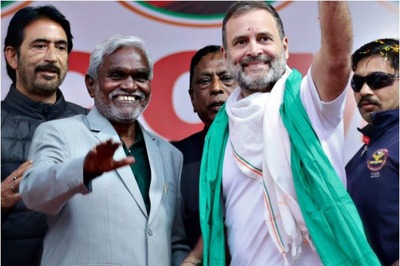
views
A peace accord that warranted the special attention the Prime Minister gave it on Twitter. Shortly after the announcement was made, I spoke to a Kilonser (Minister) of the NSCN-IM in one of the camps in Manipur, the state where the government of India’s ceasefire with the NSCN-IM technically has not applied all these years. The news of the ‘special announcement’ had reached the men. The lack of details was troubling, adding to the uncertainty. "Protecting our identity and our resources will be prime for us but yes it’s a big day, a very big day", the Kilonser said rather insipidly I imagined for a momentous day like this. Over the years as I have met the Kilonser and the cadre of the NSCN-IM either at their HQs in Camp Hebron in Nagaland or in Manipur (where the NSCN-IN camps are called ‘taken note of’ camps), the Kilonser’s faith in the ‘Naga way of life once the solution arrives’ has been rather steadfast.
Much will depend on details of the accord, the interpretation of ‘greater Nagalim’, which has remained the NSCN-IMs prime demand and the biggest roadblock-to bring together Naga dominated areas of Manipur, Arunachal and Assam. A territorial adjustment will be tough and politically infeasible giving the stiff opposition in Manipur at any tinkering of their territorial lines both within the mainstream and the underground. An ‘alternate arrangement’, a social compact of Nagas in other states along with greater autonomy for these regions maybe the parts to look out.
The form in which the NSCN-IM has accepted sovereignty, rewind a few years and it had become clear that the NSCN-IM had given up sovereignty as a goal and the Indian government had promised to incorporate a special chapter in the Indian Constitution detailing Nagaland’s special status instead of conceding to the NSCN’s demand for a separate constitution for Nagaland. The lack of details out in the public domain suggests a cautious approach by the government, perhaps waiting to see how the states of Manipur, Arunachal both with substantial Naga population react to the announcement. The issue of designated camps, armed cadre, weapons and their eventual coming in to the mainstream will all have to be set in motion in the time ahead.
Today, of course a fading memory, replaced by a handful of outfits but when the movement for Naga sovereignty started in 1946, there was one group: the Naga National Council (NNC) with AZ Phizo as its founding father. In 1980 it split. Thuingaleng Muivah, Isak Chishi Swu and S S Khaplang parted ways to form the NSCN, opposed to the NNC’s signing of Shillong Accord. Eight years later the NSCN too split in a violent parting of ways. Isak (Swu) and Muivah formed the IM, while Khaplang gave his own name to the faction, the NSCN-K. In their formal organizational name both claimed the acronym of GPRN, the government of the Peoples Republic of Nagalim. For forty years (1956-96) armed Naga insurgent groups fought India’s powerful military machine to a stalemate until both sides announced a ceasefire in 1997 and started negotiations for a settlement that has had more than 80 rounds of negotiations in destinations across the world. The NSCN-K followed suit, till it abrogated the ceasefire in 2015. And though the IM has more or less not fought the Indian forces since 1997, the ceasefire hasn’t meant peace. Its fighters continued to train, patrol, procure arms, recruit men and remain involved in turf battles with Khaplang and other breakaway Naga rebel factions.
For decades a political settlement of the Naga issue has remained out of reach. In Nehru’s words, "it was fantastic to imagine that government of India is going to be terrorized into some action by Phizo and company, privately he admitted that total suppressing of the (Naga revolt) was out of the question and partial suppression would serve only as an irritant.. the Nagas are a tough and fine lot of people and we may carry on for a generation without solving the problem."
It has taken more than a generation to end one of South Asia’s longest running guerilla campaigns. Many lives have been lost on both sides. India has used many elements of its counter-insurgency for the Naga insurrection: from military to softening up the rebels and forcing them to the table, using clan and tribe rivalries to split the separatist movement. Add to that a huge fund inflow and simply tiring down the leadership through decades of negotiations. The successful conclusion of the accord (signed by Th Muivah on behalf of the NSCN-IM and RN Ravi, the interlocutor on behalf of the Government of India) sends a right signal to make peace with groups in the region and move into a conflict resolution mode. Other Naga factions like the NSCN (KK) and NSCN R will fall in place in due course if this works out. The NSCN (Khaplang) will remain to hold out but is likely to face the brunt of coordinated operations by the Myanmar and Indian Army in the future. The Meitei groups though may continue to hold on.
At the ceremony the Prime Minister with a Naga shawl on his shoulder, spoke in English about the "prism of false perceptions and old prejudices". Muivah remarked, "beginning from now, challenges will be great". Both sides know much is at stake and much can change from now on.
(Anubha Bhonsle is the Executive Editor, CNN-IBN. Her book ‘Mother, Where’s My Country?’, a work of reportage on the web of insurgencies and the cost of conflict in Manipur releases later in 2015.)




















Comments
0 comment